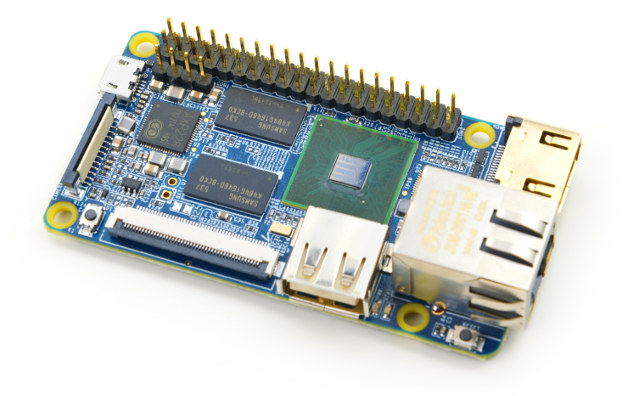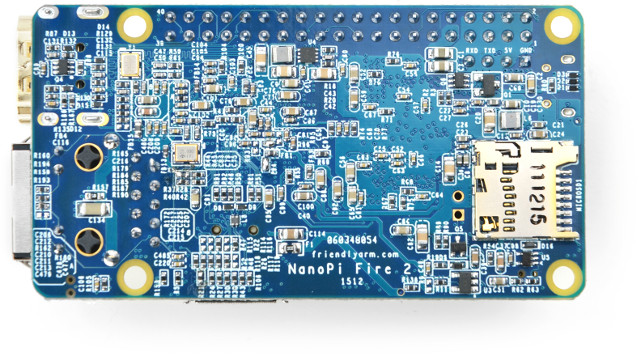NanoPi 2 board, based on Samsung S5P4418 quad core Cortex A9 processor with WiFi and Bluetooth, has now gotten a brother, called Nano Pi 2 Fire, with wireless connectivity replaced by Gigabit Ethernet, and a power management IC (PMIC) for software power-off, sleep and wakeup.

NanoPi 2 Fire specifications:
- SoC – Samsung S5P4418 quad core Cortex A9 processor @ up to 1.4GHz
- System Memory – 1GB 32bit DDR3
- Storage – 1x Micro SD Slot
- Connectivity – Gigabit Ethernet port
- Video Output / Display I/F- 1x HDMI 1.4a, 0.5 mm pitch SMT FPC seat for full-color LCD (RGB: 8-8-8)
- Camera – 24-pin DVP interface; 0.5mm pitch
- USB – 1x USB Host port; 1x micro USB 2.0 OTG port for power and data
- Expansions Headers – 40-pin Raspberry Pi compatible header with UART, I2C, SPI, GPIOs…
- Debugging – 4-pin header for serial console
- Misc – User and reset buttons, power and user LEDs, RTC battery header
- Power Supply – 5V/2A via micro USB port with AXP228 PMIC
- Dimension: 75 x 40 mm (6-layer PCB)
 The board support Android and Debian, and you can find hardware documentation on FriendlyARM’s Wiki (in construction), and software on their Github account. The Wiki should eventually get some software documentation and links to firmware images, just like for NanoPi 2 Wiki.
The board support Android and Debian, and you can find hardware documentation on FriendlyARM’s Wiki (in construction), and software on their Github account. The Wiki should eventually get some software documentation and links to firmware images, just like for NanoPi 2 Wiki.
NanoPi2 Fire will sell for $29 + shipping, and should be listed together with NanoPi2 on the company’s product page.

Jean-Luc started CNX Software in 2010 as a part-time endeavor, before quitting his job as a software engineering manager, and starting to write daily news, and reviews full time later in 2011.
Support CNX Software! Donate via cryptocurrencies, become a Patron on Patreon, or purchase goods on Amazon or Aliexpress





Does the S5P4418 have Linux Open Source drivers for hardware accelerated H264, MPEG2 and VC-1 (and HEVC/H265?) decoding?
(I’m talking about the VPU not the GPU)
Is there a board with GigE + SATA-with-port-mutiplier-support ? or a board with GigE + 4xUSB3?
Seems like there are so many for-kodi boards, and yet no diy-nas board other than the underpowered-overpriced plug devices.
it’s very hard to please everybody – NAS/server fans vs kodi fans
rpi2 it’s still the best bang for buck for both worlds
@Bogolisk
This is the closest I’ve seen: http://www.bananapi.org/p/product.html Open Media Vault does support it.
@PenComp
IIRC A20 has little or no SATA mutiplexer support.
@vickycq
A20 has PMP support, that is quite limited (especially when one keeps the write speed limitation of A20 — max. 45 MB/s under best conditions — in mind): http://linux-sunxi.org/SATA#Port_multipliers
But the idea to use them and access disks in parallel is a bit weird since performance will be bad and the PM is a single point of failure (never ever play RAID with such an insane setup!)
@Bogolisk
I hope we will see 2016 a few devices that make use of Marvell’s Armada 38x SoCs that are suited for NAS (and router) useage: While testing the Clearfog Pro a Solid-Run engineer told us how easy it is to switch external ports between PCIe and SATA therefore:
http://forum.armbian.com/index.php/topic/590-quick-review-of-solidruns-clearfog/
But since he also provided performance numbers it should be ok to just combine one SATA port with a PM to get already great disk performance. I hope some Solid-Run customers come up with devices that are based on their Armada 38x SoMs.
Is I2S exposed on either of the NanoPi2 boards? I looked at the schematics and it doesn’t look like it, but they are not crystal clear.
@Bogolisk
What about http://up-shop.org/4-up-boards? Is the only one i know about with GbE & USB 3 (OTG though).
The cloudshell project for the Odroid-XU4 offers a NAS like experience with GigEth but has only one SATA port
http://www.hardkernel.com/main/products/prdt_info.php?g_code=G143599699669
Don’t know have they fixed CPU over head issue yet. I have a WIFI+Bluetooh NanoPi version, when running with 1.4GHz CPU clock, the board is over heat quickly and CPU will hang.
@Henry
Me too. The board is over heat although It has a heat sink. And bluetooth can’t stream music to my bluetooth speakers
Too bad there’s a over heat problem on that board, it looked quite nice, do you know if its related to that CPU design or bugged kernel ?
it makes a quite pricy bundle, $100+, at that point you start to get brand nas boxes, of course if your goal is to toy with it, it’s a fair price i guess.
Also if the ports USB3 offer decent performances you can set aside the mono sata2 port limitation.
I think CPU over head issue is not caused by CPU design(S5P4418) or Linux kernel. Because the PCB is small especially its GND plane layer cannot consume heat from the CPU quickly like another PCB design.
@Henry :
the board is not that small compared to rpi2/b+.. stability problems could also come from the onboard wifi chip (along with heat problems too), i’ve seen that too many times to count, try disabling it and run some tests.
I don’t believe the ground plane will dissipate much heat from a bga package
what’s the gigabit performance on that soc ?
Last time i checked samsung had the best support for hw h264 encoding in mainline…
@Henry
i installed heatsinks 😀
@r00t
And with heatsink it doesn’t have the issues being mentioned here?
I’m considering buying one.
My NanoPi2 using the provided Debian Jessie image is running “interactive”. At idle it is running at 400MHz and I’d guess in the high 50C. Small heatsink mounted and now probably in the low 50s. I’d try some tests running ‘performance”, but so far I haven’t been able to change files in /sys/devices/system/cpu/cpu0/cpufreq/
I have Bluetooth turned off and the WiFi chip is at room temperature.
I suspect that when people use this chip in commercial product that they mount the CPU against a metal chassis or provide some other form of heatsinking. Do Samsung have any relevant app notes?
Looks good.
They have launched the NanoPi Fire 2A
http://www.friendlyarm.com/index.php?route=product/product&product_id=205
Now they have the Octa-core NanoPi Fire3
http://www.friendlyarm.com/index.php?route=product/product&path=69&product_id=206